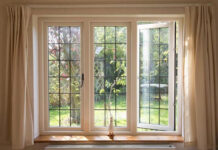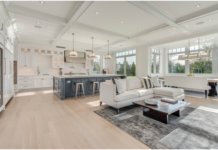The soul of a house, delicious smells, cozy evenings, family gatherings, comfortable mornings with coffee – the kitchen is the universe of every home. It is a comfortable place, which welcomes you for a relaxing drink, a board game, doing homework, talking to friends, or just having a brief break. Such an atmosphere is mainly given to furniture and lighting.
Light is a powerful design solution for any place at home, especially the kitchen. Its direct function is to light everything around so that the owners could move and perform easily. The indirect influence is much wider, as it helps to demonstrate the overall conception and mood of the place. The basic functions of kitchen lights are:
1. Ambient
This type of general lighting creates the atmosphere itself and provides enough light for feeling comfortable when moving around. It can be a combination of natural and artificial light. It is typically placed closer to the ceiling to diffuse the light and works as the cornerstone of the whole lighting scheme.
2. Decorative
According to the name, the main purpose of such lighting is the decoration and embellishment of a place. Wall sconces, chandeliers, and pendant lights – apart from their direct function, they add the aesthetic view and final touch to the whole vision of the space.
The pendant lights offered at https://alimart.ae/ hangs over the dining table and create a separate island, welcoming heart-warming kitchen talks.
3. Task
Task lighting is directed toward a specific place and is typically brighter than the ambient light. When considering the kitchen space, is typically aimed at the cooking zone and situated under the cupboards. Thus, you will have a shadow-free space worktop – a perfect solution for the cooking process.
4. Accent light
Accenting is used to highlight some specific features of the design, and draw attention to certain elements – it can be flowers, paintings, the arch, etc. It can help to create a necessary character to the room, to emphasize the most valuable features.
After deciding on the type of lighting, it’s worth remembering the general rules of light installation:
-
Before planning the lighting scheme, you need to decide on the mood you want to create, check the side of natural lighting, and define the working areas as they will need specific lighting as well.
-
As the kitchen is a calm and welcoming place, it’s better to use warm light, as it fills the place with pleasant coziness, the one that you feel during the golden hour.
-
Mix up the fixtures, yet be consistent – the kitchen is the place for your imagination, hence, playing with the shapes and forms will help to create the individual look of your space. However, despite the differences in length and form, the overall tone and mood must be matching.
-
Instead of many light zones, you can create just one – a focal point, the one that grabs everyone’s attention. It is typically placed in open-plan spaces. The main light source should be within a smart ratio: not too small, as it will get lost in the space, and not too big, as it will seem rather imposing.
As for the position – 90 centimeters above the worktop will look the best.
-
Go for oversize – the usage of oversized lighting will create a daring atmosphere in the kitchen, and create its character. However, it’s crucial to be attentive to the heights. If chosen correctly it will work both as the task and as ambient light, sharing enough light over the worktop and the whole space.
-
Mix the styles – a contemporary style kitchen will just sparkle with the finishing touch of a traditional chandelier. The classic style kitchen will benefit as well if you add daring and modern lighting.
-
Pendant lighting for dining zone – dining zones are places for sitting and enjoying meals. They boost the overall atmosphere and direct more light toward the culinary creations.
-
Large space – more light – the bigger the space is, the more lighting solutions you need to use. Don’t forget to divide it into zones, and plan the light horizontally and vertically. If there are two islands, it’s crucial to enlighten every one of them.
-
Remember about energy-saving – when choosing the types of lamps, go for LED ones, as their life span is typically 20 000+ hours, and they never harm the Earth. Besides, they will flood the kitchen with light, which is what we need.
Light is the most important part of the kitchen interior. It is a decisive factor when dividing kitchen space into separate zones. It is crucial to define the place for task lighting – illuminating the worktop and the sink, ambient – to create the overall illumination; decorative – embellishment-like lighting, and accepting – to point out special features of your kitchen.
With the properly planned lighting scheme, your kitchen will become the place of cooking, communication, and work time, the true heartbeat of your household.
Read Also: What are the benefits of choosing a Plug in Pendant Light?



































































